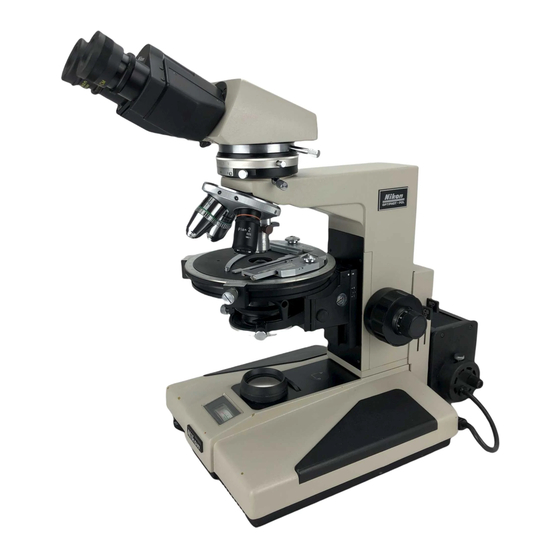Nikon OPTIPHOT-POL Petunjuk Manual - Halaman 13
Jelajahi secara online atau unduh pdf Petunjuk Manual untuk Mikroskop Nikon OPTIPHOT-POL. Nikon OPTIPHOT-POL 28 halaman. Polarizing microscope

Clamp
screw
45°
click-stop
lever
Fig. 19
For the click-stop
release, turn the lever
toward the microscope body.
•
The stage can be clamped at any position
using the stage rotation
clamp screw on
the right-hand vernier.
5) Objectives
•
The CF Achromat
P objectives (Strain-free)
and CF eyepieces adopted
in the Nikon
POLARIZING
MICROSCOPE OPTIPHOT-
PO L are designed on the basis of a concept
"Chromatic
Aberration
Free".
In every case use the CF objectives in com-
bination with the CF eyepieces.
(1) Oil immersion objectives (Oil)
•
Objective
CF Achromat
P 100X
(Oil), an
oil-immersion
type, is to be immersed in oil
between
the specimen
and front
of the
objective.
To see if air bubbles are present in the im-
mersion
oil, which
deteriorate
the image
quality,
pull
out the eyepiece from
the
eyepiece tube to examine the objective exit
pupil
inside the tube. To remove air bub-
bles, revolve the nosepiece slightly to and
fro several times, apply additional
oil, or
replace the oil. Be careful not to rotate the
nosep iece too far as to soil the ends of the
other objectives with oil.
•
To clean off the oil, pass lens tissue or soft
cloth moistened with xylene lightly two or
three times over the lens. It is essential at
this time to avoid touching
the lens with
the part of tissue or cloth once used.
(2) Coverglass
•
With the objectives engraved "160/0.17",
use a coverglass of O.17mm in thickness.
•
The indication
"160/-"
on the objective
means that no matter whether a coverglass
is used or not, no decrease of image defini-
tion or of contrast will result.
6)
Eyepieces
•
To take full advantage of the CF eyepieces,
use them
in combination
with
the CF
objectives.
•
By inserting the eyepiece with cross lines
and graduation
(CFW
10XCM)
into the
eyepiece sleeve fitting
the protractor
pin
into
the
right-hand
side groove
of the
sleeve, the O-direction of the analyzer and
dia-polarizer are al igned with the cross lines
direction.
If the protractor
pin is fitted to the upper
right side groove of the sleeve, the cross
lines will be aligned with the diagonal posi-
tion of the polarizaiton.
•
CF PL Projection
lenses are exclusively
designed for
photom icrography.
Do not
use them for observation.
---
•
For focusing with the observation tube of
the
trinocular
eyep iece tube
for
photo-
micrography,
use the eyepiece incorporat-
ing the photo mask.
7) Achromat strain-free condenser
•
The top
lens of the condenser is to be
placed in the optical
path for the ortho-
scopic and conoscopic microscopy
provid-
ed that
it is to be swung out when an
objective
of 4X or lower magnification
is
in use.
[Note]
For the orthoscopic
microscopy,
a lower numerical aperture illumi-
nation with the top lens swung out
condenser was used to be recom-
mended, however, this method is
not effective
especially
for high
magn ification
observation because
of the lowered resolution.
Hence,
for the latter case, use of the top
lens may rather be recommend-
able except the retardation
mea-
surement or the interference color
observation
for wh ich it is neces-
sary
to
make
the
illumination
light flux as parallel as possible to
the optical
axis by swinging out
the top lens or stopping down the
aperture diaphragm.
•
Thickness of the glass slide must be 1.7mm
or
less, otherwise,
the
field
diaphragm
